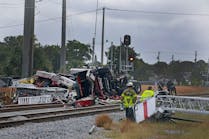With many fire departments experiencing unprecedented turnover, having older, experienced veteran drivers being replaced by younger, less experienced operators, it is important to try to learn from current events so that history does not repeat itself. So in the spirit of education and learning, we will present several recent incidents and highlight some of the lessons that can be learned or reinforced.
Legal woes
We start with an incident that prompted a father and son to file suit against the township and its fire department. According to the suit, the father was driving a pickup truck when he stopped “in deference to emergency vehicles and other stopped traffic” at the scene of a traffic accident. A rescue truck was approaching the stopped traffic when its driver “lost control of his vehicle and collided with the rear of the father’s vehicle with great force and violence, causing severe injuries,” according to the suit. The lawsuit seeks compensation for the victims’ “severe and permanent injuries”—$8,000 in medical costs for the father and $13,000 for the son, a passenger in his father’s pickup truck.
In the second incident, six firefighters were treated for non-life-threatening injuries after the fire truck they were riding in crashed. The State Highway Patrol says that the firefighters were responding to a call when the truck went off the road, hitting a culvert, ditch, mailbox and a tree. The truck was not running its lights or siren. The 60-year-old driver-operator was charged with failure to maintain reasonable control.
Many who drive emergency vehicles believe that they are in a bubble, immune from lawsuits and/or criminal charges. If you believe this—and drive like you believe this—it will be only a matter of time before your bubble bursts and you will be thrusted into the legal system. The law is neither applied equally or fairly. Both operators were reported to be driving without control of their apparatus. One was being sued civilly and the other operator was being charged criminally by the highway patrol. All training programs should emphasize the importance of preventing driver-operators from entering the legal system at any level.
If it’s predictable …
A 62-year-old battalion chief suffered minor injuries when his Ford F250 pickup was broadsided by another pickup as he made his way to an emergency. Officials said the firefighter had his lights and sirens on and was making his way against a red light through an intersection. A dump truck stopped to let the emergency vehicle pass. Officials said the driver of a 2003 Toyota Tundra went around the dump truck by switching to another lane and proceeded through the intersection on a green light. That’s when he was struck by the battalion chief’s F250. The roads were wet and slippery at the time of the accident because of recent rainfall.
For this incident, I will quote a friend and one of the best presenters in the business—Gordon Graham: “If it is predictable, it is preventable.” It is hard for most emergency vehicle operators to comprehend this, but many people do not hear us nor do they see us.
Emergency vehicle operators need to treat each lane of a multi-lane intersection as a complete and distinct intersection unto itself. If you are not assured that the traffic is stopped, you simply cannot proceed; you must stop. Also, when negotiating an intersection, you must look left, right, left, and must make sure that not only the first vehicle in line is stopped and yielding, but also that all vehicles in that line are stopped and yielding to you.
With inattentive driving as the national norm, what can happen is both predicable and preventable. A vehicle four or five cars deep sees cars stopped. They cannot see you, they cannot hear you, and they are in a hurry. Next they pull into an unoccupied traffic lane, turn lane or even, in some cases, onto the shoulder. They now drive around all the cars that are yielding to you and end up right underneath you. The results of this type of collision can be devastating for both the fire apparatus and the civilian vehicle or vehicles involved.
Saving our own
A good article by Neil Sjostrom talks about saving our own in a much different way than you might suspect. When it comes to vehicle extrication a custom fire truck is arguably the most difficult vehicle that you will have to perform an extrication on. This article walks you through the necessary steps to perform a successful fire apparatus extrication. Read it at http://tinyurl.com/appar-extr.
Until next time, be safe!

Michael Wilbur
MICHAEL WILBUR, who is a Firehouse contributing editor, retired as a lieutenant in FDNY, where he was last assigned to Ladder Company 27 in the Bronx. He has served on FDNY's Apparatus Purchasing Committee and consults on a variety of apparatus-related issues around the country. Wilbur is a member of the Firehouse Hall of Fame. For further information, access his website at www.emergencyvehicleresponse.com.






